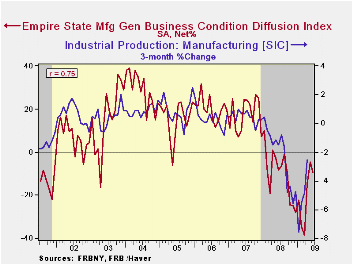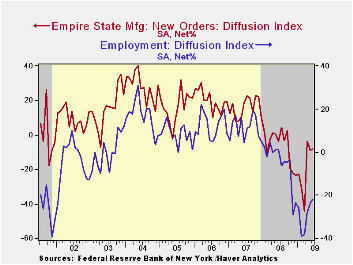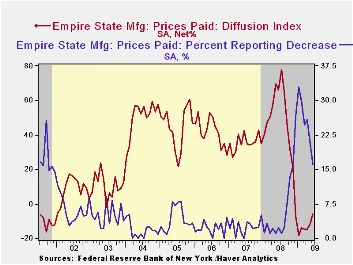 Global| Jun 15 2009
Global| Jun 15 2009Empire State Factory Conditions Deteriorated M/M But Remain Improved From Earlier Low
by:Tom Moeller
|in:Economy in Brief
Summary
This month's Empire State Index of manufacturing sector activity, reported by the Federal Reserve Bank of New York, fell versus May. Nevertheless, the latest reading remained very much improved from the low of this past Winter and, as [...]
 This
month's Empire State Index of manufacturing sector activity, reported
by the Federal Reserve Bank of New York, fell versus May. Nevertheless,
the latest reading remained very much improved from the low of this
past Winter and, as a result, suggests that recessionary forces have
moderated. The reading of -9.41 compared with -4.55 in May. The index
reached a level of -38.23 this past March and the latest level compared
to Consensus expectations for a reading of -4.5.
This
month's Empire State Index of manufacturing sector activity, reported
by the Federal Reserve Bank of New York, fell versus May. Nevertheless,
the latest reading remained very much improved from the low of this
past Winter and, as a result, suggests that recessionary forces have
moderated. The reading of -9.41 compared with -4.55 in May. The index
reached a level of -38.23 this past March and the latest level compared
to Consensus expectations for a reading of -4.5.
The Empire State Manufacturing Survey is a monthly survey of manufacturers in New York State. Participants from across the state in a variety of industries respond to a questionnaire and report the change in indicators from the previous month. Respondents also state the likely direction of these same indicators six months ahead. For more on the Empire State Manufacturing Survey, including methodologies and the latest report, click here.
The figure is a diffusion index. Since the series' inception in 2001,
there has been a 75% correlation between its level and the three-month
change in U.S. factory sector industrial production. Like the
Philadelphia Fed Index of General Business Conditions, the Empire State
Business  Conditions Index reflects answers to independent survey
questions; it is not a weighted combination of the components. The
series dates back only to 2001.
Conditions Index reflects answers to independent survey
questions; it is not a weighted combination of the components. The
series dates back only to 2001.
Deterioration in the component of the June survey was limited to shipments and inventories. Otherwise, the new orders index improved modestly to -8.15 and that compares to March's reading of -44.76. Twenty-five percent of survey participants reported higher new orders, versus the March low of nine percent. The employment index also improved to the highest level since last October. Fourteen percent of respondents reported higher employment versus the March low of 4.5%. In the history of the NY employment index, there has been an 87% correlation between it and the three-month growth in overall U.S. factory sector employment as reported by the Labor Department. The length of the average workweek also grew.
Price
deflation also moderated as the rate of contraction in the factory
sector slowed. The price index rose to its highest level since late
last year as the number of respondents reporting lower prices fell
sharply to 16%, half of the percentage of this past January. Only 10%
of respondents reported paying higher prices and that was near the
series' low. Since inception in 2001, there has been a 76% correlation
between the index of prices paid and the three-month change in the core
intermediate materials PPI.
half of the percentage of this past January. Only 10%
of respondents reported paying higher prices and that was near the
series' low. Since inception in 2001, there has been a 76% correlation
between the index of prices paid and the three-month change in the core
intermediate materials PPI.
The Empire State index of expected business conditions in six months improved during June to the highest level since mid-2007. The subseries for shipments, employment and capital expenditures jumped while prices paid and new orders remained off their lows.
The Empire State data is available in Haver's SURVEYS database.
Large Banks and Small Banks in an Era of Systemic Risk Regulation is this morning's speech by Fed Governor Daniel K. Tarullo and it can be found here.
| Empire State Manufacturing Survey | June | May | June '08 | 2008 | 2007 | 2006 |
|---|---|---|---|---|---|---|
| General Business Conditions (diffusion index, %) | -9.41 | -4.55 | -8.12 | -10.10 | 17.23 | 20.24 |
| New Orders | -8.15 | -9.01 | -3.73 | -6.25 | 15.71 | 20.11 |
| Employment | -21.84 | -23.86 | 1.16 | -5.36 | 11.28 | 12.62 |
| Prices Paid | -5.75 | -11.36 | 66.28 | 46.99 | 35.64 | 41.88 |
Tom Moeller
AuthorMore in Author Profile »Prior to joining Haver Analytics in 2000, Mr. Moeller worked as the Economist at Chancellor Capital Management from 1985 to 1999. There, he developed comprehensive economic forecasts and interpreted economic data for equity and fixed income portfolio managers. Also at Chancellor, Mr. Moeller worked as an equity analyst and was responsible for researching and rating companies in the economically sensitive automobile and housing industries for investment in Chancellor’s equity portfolio. Prior to joining Chancellor, Mr. Moeller was an Economist at Citibank from 1979 to 1984. He also analyzed pricing behavior in the metals industry for the Council on Wage and Price Stability in Washington, D.C. In 1999, Mr. Moeller received the award for most accurate forecast from the Forecasters' Club of New York. From 1990 to 1992 he was President of the New York Association for Business Economists. Mr. Moeller earned an M.B.A. in Finance from Fordham University, where he graduated in 1987. He holds a Bachelor of Arts in Economics from George Washington University.






